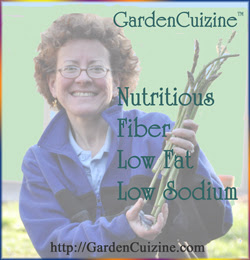"Good Stuff"
Stuffing with Hot Peppers
from the Garden!
Our mouths were tingling this Thanksgiving from the aromatic, heart-healthy, stuffing made with Capsicum chinense 'Yellow Mushroom' hot peppers from our garden!
"What's in the stuffing?" was the question asked from someone who used to get heartburn from high fat, high calorie stuffing in the past. Nothing fancy, just a simple classic stuffing with a few added hot peppers. Hot peppers are easy and fun to grow. Try growing some in your garden.
Okay, so I tossed in a persimmon too! This was our year for experimenting with persimmons in the kitchen. The mild, sweet flavor
of persimmon gets lost when combined with anything spicy, I've noticed. But, persimmons add nutrients and dietary fiber.
Heart Healthy Stuffing
No need to add Salt
Think about the main ingredient - bread. Read the bread label. Bread contributes plenty of sodium.
Low Fat
With plenty of protein from your main entree, their really is no need for added protein in the stuffing, let alone the added saturated fat and calories that meats like bacon or sausage contribute. So at Thanksgiving at our house - you won't find added high fat sausage in stuffing anymore. Gone are the Andouille sausage stuffing days. But, guess what? This was "Good Stuff!" It pleased even the most picky eaters and those seeking pronounced flavor in stuffing.
Does your stuffing recipe call for using a whole stick (or two!!) of butter or dotting the casserole with butter? Do your arteries a favor, just use a small amount of olive oil when cooking the veggies. Trust me, this stuffing has plenty of flavor and your family will NOT miss the saturated fat and dietary cholesterol from the butter.
GardenCuizine Freestyle Recipe: meaning, no need to measure out ingredients. I'll note what I used, but exact measurements are not necessary. Recipe for 8x8 baking dish.
Ingredients
1/2 loaf Challah and/or whole grain bread cubes (or enough to fill up your baking dish)
2/3 cup chopped Celery
Hot Peppers* any kind (we used 2 Yellow mushroom peppers)
2/3 cup chopped Onion
2/3 cup chopped Carrots
1 teaspoon dried Thyme leaves
1 teaspoon ground Sage*
1 teaspoon dried Marjoram*
1/8 teaspoon fresh ground Black Pepper
1/2 teaspoon dried crushed Rosemary*
2 Tablespoons chopped Parsley
1 3/4 cups plus 12 ounces Turkey stock (or vegetable stock if you want to keep the recipe vegetarian) Note: if you're roasting a Turkey make a small pot of stock with the giblets, water and chopped carrots, celery, onion, bay leaves, parsley stems and black peppercorns. Turkey stock can be used for gravy too!
3 Eggs
1/8 teaspoon ground Nutmeg
Persimmon (optional) - we used American native Diospyros virginiana
1 to 2 Tablespoons Olive oil
*or 1 tsp poultry seasoning
Putting it all together
- Butter your baking dish.
- Chop up your veggies and saute them in 1-2 tablespoons olive oil until fragrant and somewhat tender. *The key to this recipe is to add just enough hot pepper to please both those who like spicy and those who don't like their food too spicy. Sprinkle sage, rosemary, thyme and marjoram over the veggies while cooking. Ladle in a few scoops (about 12 ounces) of turkey broth. Simmer until carrots are tender and turn off heat and let cool.
- Meanwhile, cube the bread - no need to let it go stale or dry it out. In a large bowl toss the bread cubes with chopped parsley.
- Add in the sauteed vegetables; stir gently to combine and scoop into baking dish.
- In another bowl whisk 1 3/4 cups cooled stock with the eggs; add nutmeg (you can add a chopped, ripe persimmon - optional). Pour the liquid egg mixture over the seasoned bread cubes. It should be good and moist almost like a bread pudding. Add more broth as needed. You should see the liquid, but it should not cover the top layer of bread cubes.
- Bake at 350°F covered until set (about 30 minutes), remove cover to brown top layer (another 15 minutes or so).
Buon Appetito!
Photos and blog post Copyright (C) Wind. All rights reserved. Revised 11/26/2021



















































